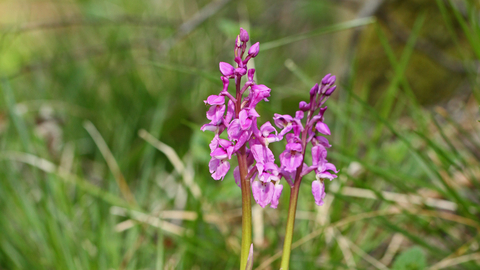By Steve Aylward

Wood anemone - Bruce Shortland
By Steve Aylward

Early purple orchid by Steve Aylward
By Steve Aylward

Willow warbler - Amy Lewis
By Steve Aylward
By Steve Aylward
Bonny Wood Nature Reserve
Know before you go
Dogs
When to visit
Opening times
Open at all timesBest time to visit
April to JuneAbout the reserve
First a walk through the rolling countryside of the Suffolk heartland, a patchwork of fields veined with mature hedgerows, quiet villages and church steeples; before taking a step back in time and into the closeted green rides of an ancient coppice woodland. Parking at Barking Village Hall, turn left out of the car park and walk about 200m along the wide grass verge towards a public footpath that snakes its way past Overhall Farm on your right. The route isn’t brilliantly signposted, so visitors need eagle-eyes to spot the wooden steps 100m away from the barn in the field to the right. The path, which is bordered by old hedges packed with haws, hips and blackberries, leads to a small wooden bridge. Turn left over the bridge and follow the path’s curve through tangled copse to the start of a track that crosses a clearing to hug the emerald green edges of Bonny Wood all the way to the reserve’s entrance. Reaching the woods takes about 15 to 20 minutes, but it is well worth the effort.
Part of the Barking Tye woods, which are a Site of Special Scientific Interest, the best time to visit is from late April to late June when the coppiced areas are brimming with wood anemone, woodruff and herb-paris. Orchids are also typical, with species recorded in Bonny including early-purple orchids, lesser twayblade, common spotted orchid. The luckiest of visitors might even be able to spot a greater butterfly orchid. Birds are also plentiful at this time of year with melodies from summer migrants such as blackcap and willow warbler mingling with the song of resident species. There are also frequent sightings of hobby and at dusk the woodcock’s ‘roding’ mating display can sometimes be glimpsed in the wood. But with a 25 minute circular walk that takes in atmospheric rides, glades and coppices, there are plenty of reasons to visit Bonny Wood at other times of the year – whether it is looking for the tracks of badger and deer, or picking past hazel stools that possess the same kind of other-worldly aura as any ancient monument hewn from stone.
Indeed, the magic of Bonny Wood, whose roots can be traced back to 1251, is not just in its abundant flora and fauna but in its cultural dimension – with coppice stools providing a living link to hundreds of years of human history and endeavour. Records from show the wood was coppiced on a seven to eight year rotation from 1356 (the Trust currently uses a 25 year rotation to benefit woodland species), with Elizabeth I purchasing Bonny Wood from the Bishop of Ely in 1561, before James I sold it on in 1611. The wood, which eventually passed to the Ashburnham Estate and then to the Trust in 1987, has been harvested for everything from firewood to hop poles, hurdles and thatching spars. Walking back down to Barking, it is worth stopping and thinking of just how many of the buildings seen in the distance have relied on these coppices at some point in the past.
Habitat
Contact us
Environmental designation
Location map
What is coppicing, and why is it important?
In this short film, Alex Lack (Woodlands Warden at Suffolk Wildlife Trust) explains the long tradition of coppicing at Bradfield Woods and the vital role this ancient woodland management technique plays in creating wildlife-rich habitats.
The History and Importance of Coppicing (https://www.youtube.com/watch?v=y55_14LBWAM&t)
Featuring Alex Lack. Filmed and editted by John Collins.

